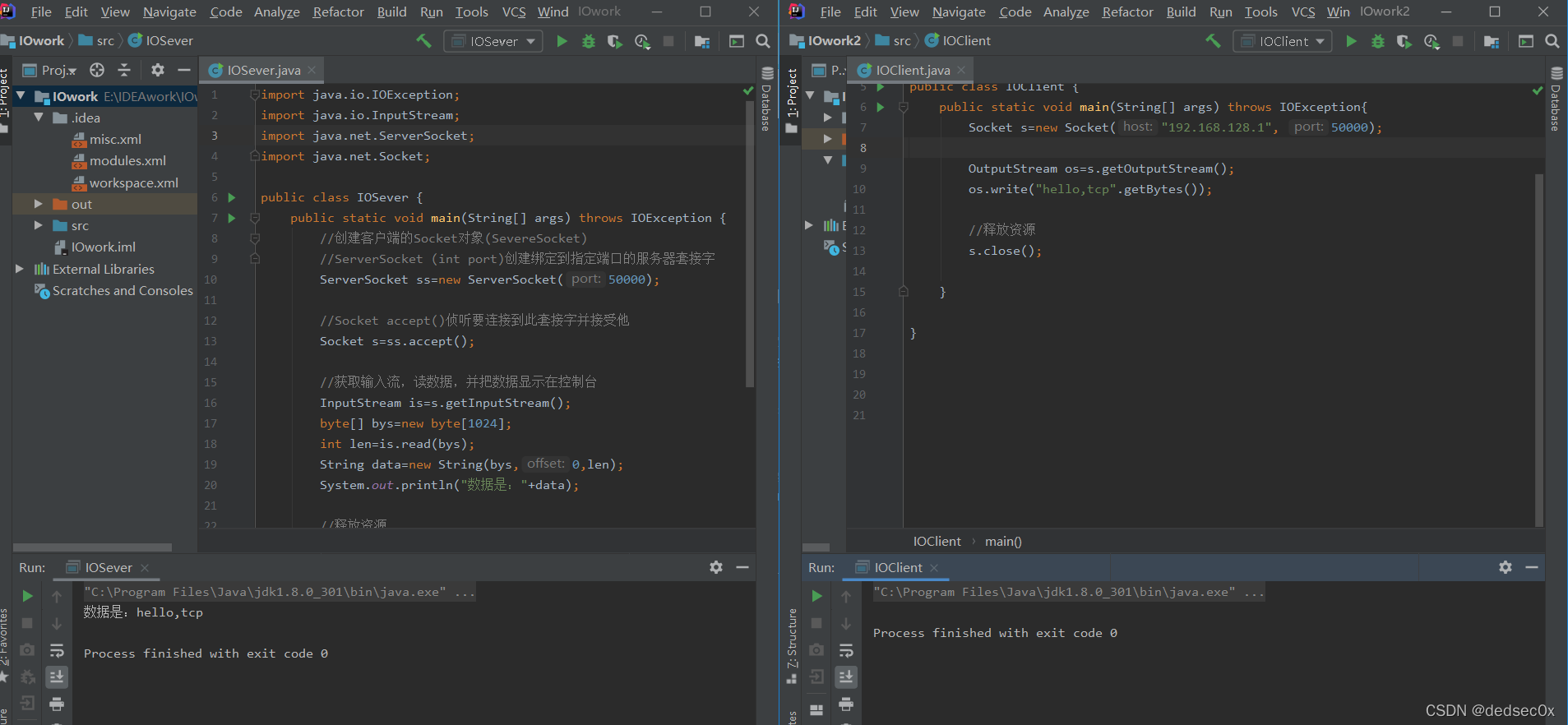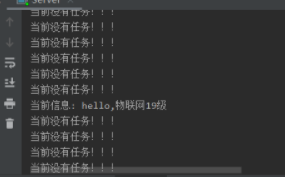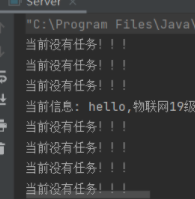一、基础知识
(一)IO和NIO的概念
IO
Java IO 也称为IO流,IO = 流,它的核心就是对文件的操作,对于 字节 、字符类型的输入和输出流。IO是指对数据流的输入和输出,也称为IO流,IO流主要分为两大类,字节流和字符流。字节流可以处理任何类型的数据,如图片,视频等,字符流只能处理字符类型的数据。IO流的本质是数据传输,并且流是单向的。
NIO
JAVA NIO有两种解释:一种叫非阻塞IO(Non-blocking I/O),另一种也叫新的IO(New I/O),其实是同一个概念。它是一种同步非阻塞的I/O模型,也是I/O多路复用的基础,已经被越来越多地应用到大型应用服务器,成为解决高并发与大量连接、I/O处理问题的有效方式。NIO是一种基于通道和缓冲区的I/O方式,它可以使用Native函数库直接分配堆外内存(区别于JVM的运行时数据区),然后通过一个存储在java堆里面的DirectByteBuffer对象作为这块内存的直接引用进行操作。这样能在一些场景显著提高性能,因为避免了在Java堆和Native堆中来回复制数据。
IO和NIO之间的区别
NIO和传统IO(一下简称IO)之间第一个最大的区别是,IO是面向流的,NIO是面向缓冲区的。 Java IO面向流意味着每次从流中读一个或多个字节,直至读取所有字节,它们没有被缓存在任何地方。此外,它不能前后移动流中的数据。如果需要前后移动从流中读取的数据,需要先将它缓存到一个缓冲区。NIO的缓冲导向方法略有不同。数据读取到一个它稍后处理的缓冲区,需要时可在缓冲区中前后移动。这就增加了处理过程中的灵活性。但是,还需要检查是否该缓冲区中包含所有您需要处理的数据。而且,需确保当更多的数据读入缓冲区时,不要覆盖缓冲区里尚未处理的数据。
IO的各种流是阻塞的。这意味着,当一个线程调用read() 或 write()时,该线程被阻塞,直到有一些数据被读取,或数据完全写入。该线程在此期间不能再干任何事情了。 NIO的非阻塞模式,使一个线程从某通道发送请求读取数据,但是它仅能得到目前可用的数据,如果目前没有数据可用时,就什么都不会获取。而不是保持线程阻塞,所以直至数据变得可以读取之前,该线程可以继续做其他的事情。 非阻塞写也是如此。一个线程请求写入一些数据到某通道,但不需要等待它完全写入,这个线程同时可以去做别的事情。 线程通常将非阻塞IO的空闲时间用于在其它通道上执行IO操作,所以一个单独的线程现在可以管理多个输入和输出通道(channel)。
(二)Netty
Netty 是基于 Java NIO 的异步事件驱动的网络应用框架,使用 Netty 可以快速开发网络应用,Netty 提供了高层次的抽象来简化 TCP 和 UDP 服务器的编程,但是你仍然可以使用底层的 API。
Netty 的内部实现是很复杂的,但是 Netty 提供了简单易用的API从网络处理代码中解耦业务逻辑。Netty 是完全基于 NIO 实现的,所以整个 Netty 都是异步的。
Netty 是最流行的 NIO 框架,它已经得到成百上千的商业、商用项目验证,许多框架和开源组件的底层 rpc 都是使用的 Netty,如 Dubbo、Elasticsearch 等等。下面是官网给出的一些 Netty 的特性:
设计方面
- 对各种传输协议提供统一的 API(使用阻塞和非阻塞套接字时候使用的是同一个 API,只是需要设置的参数不一样)。
- 基于一个灵活、可扩展的事件模型来实现关注点清晰分离。
- 高度可定制的线程模型——单线程、一个或多个线程池。
- 真正的无数据报套接字(UDP)的支持(since 3.1)。
易用性
- 完善的 Javadoc 文档和示例代码。
- 不需要额外的依赖,JDK 5 (Netty 3.x) 或者 JDK 6 (Netty 4.x) 已经足够。
性能
- 更好的吞吐量,更低的等待延迟。
- 更少的资源消耗。
- 最小化不必要的内存拷贝。
安全性
- 完整的 SSL/TLS 和 StartTLS 支持
二、基于IO的JAVA网络程序
客户端:
import java.io.IOException;
import java.io.OutputStream;
import java.net.Socket;
public class IOClient {
public static void main(String[] args) throws IOException{
Socket s=new Socket("192.168.128.1", 50000);
OutputStream os=s.getOutputStream();
os.write("hello,tcp".getBytes());
//释放资源
s.close();
}
}
服务端:
import java.io.IOException;
import java.io.InputStream;
import java.net.ServerSocket;
import java.net.Socket;
public class IOSever {
public static void main(String[] args) throws IOException {
//创建客户端的Socket对象(SevereSocket)
//ServerSocket (int port)创建绑定到指定端口的服务器套接字
ServerSocket ss=new ServerSocket(50000);
//Socket accept()侦听要连接到此套接字并接受他
Socket s=ss.accept();
//获取输入流,读数据,并把数据显示在控制台
InputStream is=s.getInputStream();
byte[] bys=new byte[1024];
int len=is.read(bys);
String data=new String(bys,0,len);
System.out.println("数据是:"+data);
//释放资源
s.close();
ss.close();
}
}
效果:

三、NIO
服务端:
import java.net.InetSocketAddress;
import java.nio.ByteBuffer;
import java.nio.channels.SelectionKey;
import java.nio.channels.Selector;
import java.nio.channels.ServerSocketChannel;
import java.nio.channels.SocketChannel;
import java.util.Iterator;
import java.util.Set;
public class Server {
//网络通信IO操作,TCP协议,针对面向流的监听套接字的可选择通道(一般用于服务端)
private ServerSocketChannel serverSocketChannel;
private Selector selector;
/*
*开启服务端
*/
public void start(Integer port) throws Exception {
serverSocketChannel = ServerSocketChannel.open();
selector = Selector.open();
//绑定监听端口
serverSocketChannel.socket().bind(new InetSocketAddress(port));
//设置为非阻塞模式
serverSocketChannel.configureBlocking(false);
//注册到Selector上
serverSocketChannel.register(selector, SelectionKey.OP_ACCEPT);
startListener();
}
private void startListener() throws Exception {
while (true) {
// 如果客户端有请求select的方法返回值将不为零
if (selector.select(1000) == 0) {
System.out.println("当前没有任务!!!");
continue;
}
// 如果有事件集合中就存在对应通道的key
Set<SelectionKey> selectionKeys = selector.selectedKeys();
Iterator<SelectionKey> iterator = selectionKeys.iterator();
// 遍历所有的key找到其中事件类型为Accept的key
while (iterator.hasNext()) {
SelectionKey key = iterator.next();
if (key.isAcceptable())
handleConnection();
if (key.isReadable())
handleMsg(key);
iterator.remove();
}
}
}
/**
* 处理建立连接
*/
private void handleConnection() throws Exception {
SocketChannel socketChannel = serverSocketChannel.accept();
socketChannel.configureBlocking(false);
socketChannel.register(selector, SelectionKey.OP_READ, ByteBuffer.allocate(1024));
}
/*
* 接收信息
*/
private void handleMsg(SelectionKey key) throws Exception {
SocketChannel channel = (SocketChannel) key.channel();
ByteBuffer attachment = (ByteBuffer) key.attachment();
channel.read(attachment);
System.out.println("当前信息: " + new String(attachment.array()));
}
public static void main(String[] args) throws Exception {
Server myServer = new Server();
myServer.start(8887);
}
}
客户端:
import java.net.InetSocketAddress;
import java.nio.ByteBuffer;
import java.nio.channels.SocketChannel;
public class Click {
public static void main(String[] args) throws Exception {
SocketChannel socketChannel = SocketChannel.open();
socketChannel.configureBlocking(false);
// 连接服务器
if (!socketChannel.connect(new InetSocketAddress("192.168.0.179", 8887))) {
while (!socketChannel.finishConnect()) {
System.out.println("connecting...");
}
}
//发送数据
String str = "hello,物联网19级";
ByteBuffer byteBuffer = ByteBuffer.wrap(str.getBytes());
socketChannel.write(byteBuffer);
System.in.read();
}
}
效果

四、Netty
服务端:
import io.netty.bootstrap.ServerBootstrap;
import io.netty.channel.*;
import io.netty.channel.nio.NioEventLoopGroup;
import io.netty.channel.socket.SocketChannel;
import io.netty.channel.socket.nio.NioServerSocketChannel;
import io.netty.handler.codec.string.StringDecoder;
import io.netty.handler.codec.string.StringEncoder;
import java.net.InetSocketAddress;
/**
*
*/
public class Server {
private int port;
public static void main(String[] args){
new Server(12345).start();
}
public Server(int port) {
this.port = port;
}
public void start() {
/**
* 创建两个EventLoopGroup,即两个线程池,boss线程池用于接收客户端的连接,
* 一个线程监听一个端口,一般只会监听一个端口所以只需一个线程
* work池用于处理网络连接数据读写或者后续的业务处理(可指定另外的线程处理业务,
* work完成数据读写)
*/
EventLoopGroup boss = new NioEventLoopGroup(1);
EventLoopGroup work = new NioEventLoopGroup();
try {
/**
* 实例化一个服务端启动类,
* group()指定线程组
* channel()指定用于接收客户端连接的类,对应java.nio.ServerSocketChannel
* childHandler()设置编码解码及处理连接的类
*/
ServerBootstrap server = new ServerBootstrap()
.group(boss, work).channel(NioServerSocketChannel.class)
.localAddress(new InetSocketAddress(port))
.option(ChannelOption.SO_BACKLOG, 128)
.childOption(ChannelOption.SO_KEEPALIVE, true)
.childHandler(new ChannelInitializer<SocketChannel>() {
@Override
protected void initChannel(SocketChannel ch) throws Exception {
ch.pipeline()
.addLast("decoder", new StringDecoder())
.addLast("encoder", new StringEncoder())
.addLast(new HelloWorldServerHandler());
}
});
//绑定端口
ChannelFuture future = server.bind().sync();
System.out.println("server started and listen " + port);
future.channel().closeFuture().sync();
} catch (Exception e) {
e.printStackTrace();
}finally {
boss.shutdownGracefully();
work.shutdownGracefully();
}
}
public static class HelloWorldServerHandler extends ChannelInboundHandlerAdapter {
@Override
public void channelActive(ChannelHandlerContext ctx) throws Exception {
System.out.println("HelloWorldServerHandler active");
}
@Override
public void channelRead(ChannelHandlerContext ctx, Object msg) throws Exception {
System.out.println("server channelRead..");
System.out.println(ctx.channel().remoteAddress()+"->Server :"+ msg.toString());
ctx.write("server write"+msg);
ctx.flush();
}
}
}
客户端:
import io.netty.bootstrap.Bootstrap;
import io.netty.channel.*;
import io.netty.channel.nio.NioEventLoopGroup;
import io.netty.channel.socket.SocketChannel;
import io.netty.channel.socket.nio.NioSocketChannel;
import io.netty.handler.codec.string.StringDecoder;
import io.netty.handler.codec.string.StringEncoder;
/**
*
*/
public class Click {
private static final String HOST = "localhost";
private static final int PORT= 12345;
public static void main(String[] args){
new Click().start(HOST, PORT);
}
public void start(String host, int port) {
EventLoopGroup group = new NioEventLoopGroup();
try {
Bootstrap client = new Bootstrap().group(group).channel(NioSocketChannel.class)
.option(ChannelOption.TCP_NODELAY, true).handler(new ChannelInitializer<SocketChannel>() {
@Override
protected void initChannel(SocketChannel ch) throws Exception {
ch.pipeline()
.addLast("decoder", new StringDecoder())
.addLast("encoder", new StringEncoder())
.addLast(new HelloWorldClientHandler());
}
});
ChannelFuture future = client.connect(host, port).sync();
future.channel().writeAndFlush("Hello Netty Server ,I am a netty client");
future.channel().closeFuture().sync();
} catch (Exception e) {
e.printStackTrace();
} finally {
group.shutdownGracefully();
}
}
public static class HelloWorldClientHandler extends ChannelInboundHandlerAdapter {
@Override
public void channelActive(ChannelHandlerContext ctx) throws Exception {
System.out.println("HelloWorldClientHandler Active");
}
@Override
public void channelRead(ChannelHandlerContext ctx, Object msg) throws Exception {
System.out.println("HelloWorldClientHandler read Message:"+msg);
}
}
}
效果

五、参考
(92条消息) Java NIO原理与简单实现_lhrimperial的专栏-优快云博客_java nio原理




 本文介绍了JAVA中的IO和NIO概念,IO是面向流的,而NIO是面向缓冲区的,具有非阻塞特性。Netty是基于Java NIO的异步事件驱动网络应用框架,提供了高性能、易用的特性,广泛应用于各种网络应用中。
本文介绍了JAVA中的IO和NIO概念,IO是面向流的,而NIO是面向缓冲区的,具有非阻塞特性。Netty是基于Java NIO的异步事件驱动网络应用框架,提供了高性能、易用的特性,广泛应用于各种网络应用中。
















 825
825

 被折叠的 条评论
为什么被折叠?
被折叠的 条评论
为什么被折叠?








